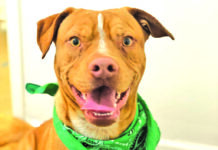
I love the summer – most of the time. I could do without the super-hot temperatures, thank you very much. My dog, Gabby, feels the same way. The dog days of summer offer opportunities for fun with a pup – camping, swimming, kayaking, backpacking and Gabby’s favorite: hiking. Summer’s heat brings a unique set of health hazards and risks.
Dehydration is probably one of the most common problems. One of the best ways to keep dogs safe in the summer heat is by providing cool, fresh water. Consider preparing low-sodium chicken broth or yogurt ice cubes to increase the moisture content in a dogs diet. An added benefit is watching a dog try to chew an ice cube – adorable.
The pads of a pup’s feet are super sensitive to heat. Under the summer sun, asphalt and sidewalks can heat to temperatures that can scald a dog. To avoid scorched paws, walk the pooch very early in the morning or in the late evening when the streets have cooled off. Test the asphalt for about 30 seconds by touching it – if it’s too hot, it’s too hot for Fido.
Summer is the season for fleas, ticks and mosquitoes – pests which can present a minor discomfort to a dog at best, and at worst may be life-threatening or cause self-mutilating behaviors. Author and dog expert Casey Lomonaco suggests that “Feeding your dog a high-quality diet without preservatives or chemicals will build his immune system, making him more resistant to parasite infestation.” Keeping a dog well-groomed will also reduce the risk of parasite infestation.
Heat stroke is a serious risk to a dog’s health. In worst-case scenarios, it can be fatal. Lomonaco stressed, “You can prevent heat stroke by restricting your pet’s exercise during the hottest hours of the day (early morning or late evening are the best times for exercise during the summer), by making sure he is well-hydrated, providing cool places for him to relax, providing opportunities to swim, cooling mats and by never leaving your dog unattended in the car during summer heat.”
“Because dogs don’t sweat, except for some from their paw pads, they aren’t as efficient at cooling off as people and are more susceptible to heat stroke,” said Dr. Gene Mueller, president of the Anti Cruelty Society. “There’s no one agency that keeps track of how often dogs die in hot cars but even one is too many.”
According to Dr. Louise Murray, director of medicine at the American Society for the Prevention of Cruelty to Animals (ASPCA), “Normal adult humans wouldn’t just sit and boil in a car, they’d get out. But dogs don’t have a choice if the doors are closed. Sadly, these cases of fatal heat stroke are preventable – it shouldn’t happen.
“Even if windows are cracked or a vehicle is parked in the shade, heat can quickly build inside during the summer, turning a vehicle into an oven. If it’s 85 degrees at noon and the windows are cracked, the temperature in the car may still rise as high as 115 degrees.” Don’t leave a dog in a hot car – not even for five minutes.
Just like humans, dogs may be allergic to one or more seasonal items, including fleas, grass, various plants and mold. A visit to a veterinarian is recommended if a dog is suspected of having seasonal allergies, is scratching or losing fur.
Remember to use common sense when out and about with a dog in the summertime. As they say, “An ounce of prevention is worth a pound of cure.”
Lori Fusaro has been voted the best portrait photographer by FoxTV three years in a row. She lives in Culver City with her husband, four cats and dog. Contact: Lori@FusaroPhotography.com or FusaroPhotography.com.












